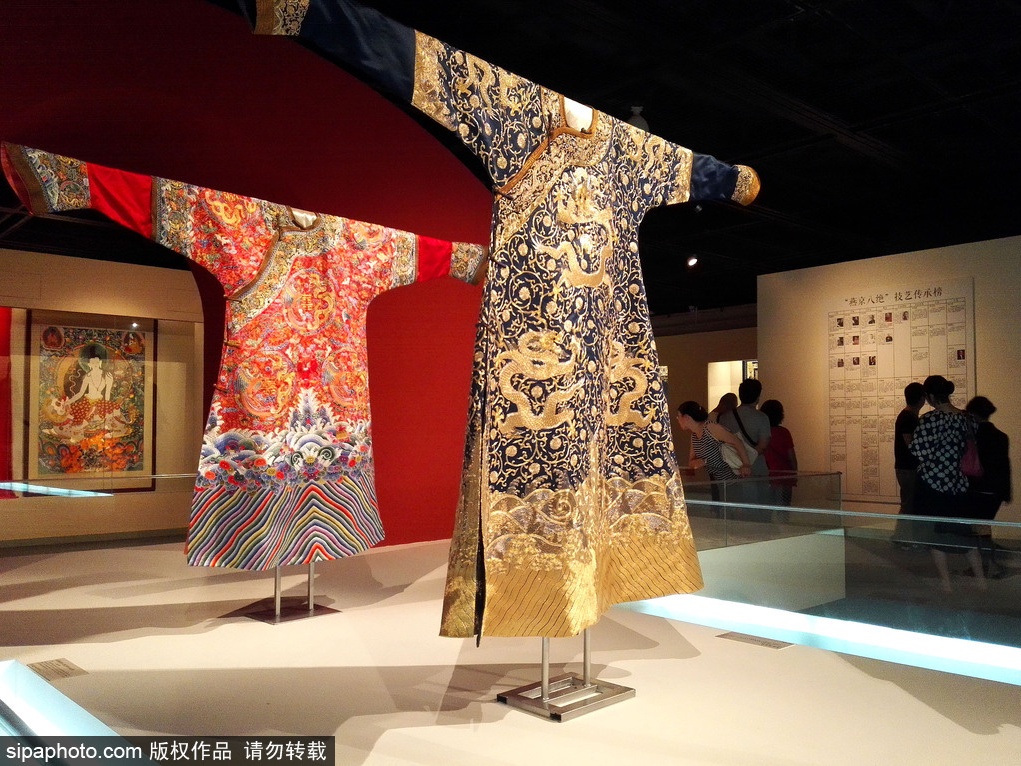
Beijing embroidery features elegance, elaboration, beautiful patterns, diverse stitches, skillful needlework, and vivid images. Beijing embroidery is made of choice materials. The materials are very expensive and luxurious. The most distinctive feature of Beijing embroidery is the bright-colored embroidery threads, close to famille rose and enamel colors used in porcelain. Beijing embroidery outclasses Suzhou embroidery for flat surface, skillful stitches and thin threads, well-balanced lines, and bright colors.
Beijing embroidery values more on the propitious connotations of design patterns, featuring meaningful patterns and auspicious decorative design. The patterns mainly include dragon, eight auspicious symbols of Buddhism, eight auspicious symbols of Tibetan painting, seawater, rivers, and cliffs.
The main colors used in Beijing embroidery are black, yellow, red, and blue. Black means profoundness, yellow power, red happiness, and blue nobleness. Representative products of Beijing embroidery include royal supplies, mandarin squares of the Qing Dynasty, Eight Immortals, and Hundred Son Diagram.
Where to buy: Jing Cheng Bai Gong Fang (A Beijing workshop with 100 craftsmen)
Address: No. 12, B, Guangming Road, Dongcheng District, Beijing
Bai Gong Fang, literally meaning “100 Handicraftsmen Workshop” in Chinese, is located at Dongcheng District, central Beijing. It is hailed as a museum devoted to keeping hundreds of unique Chinese arts alive.
The name of the studio derives from the departments in the Yuan, Ming and Qing Dynasties. At that time, the emperors conscripted outstanding craftsmen all over the country to set up shops in Beijing. And then, people called the street where the shops situated Bai Gong Fang.
The space is consisted of about 30 studios and home to over 100 kinds of traditional Chinese art and crafts practiced by masters who’ve trained all their lives to reach perfection in their chosen trade. Even some of the crafts are listed the directory of Intangible Heritages while part of them are on the edge of dying out.
Not only can you purchase various exquisite crafts but also practice making handicrafts.
Address: B12 Guangming Road, Dongcheng District东城区光明路乙12号
Route: Subway Line 5, Tiantan Dongmen Station (天坛东门), Exit B
Opening Hours: 9am-5pm daily
Refosian
Founded in 1862 by Meng Luochuan, a descendant of Mencius, Refosian is a famous silk fabric brand in China. The first shop in Beijing was opened in 1893. It boasts its exquisite techniques to make traditional Chinese clothing and some of the skills have been identified as Beijing intangible cultural heritages.
Refosian is well-known for its top quality silk fabrics and tailored Chinese clothes. Qipao (Cheongsam), one of its signature clothes, involves a dozen procedures and many traditional skills, such as hand sewing, Chinese ribbon buttons making and embroidery skills. Its embroidery is characterized by the use of luxurious gold and silver threads and more than one hundred types of buttons which symbolize good luck, longevity, wealth and strength. Apart from clothes, Refosian also sells shoes, accessories, fur items and textile products.
Qianmen Store
Address: No. 5 Dashilan Street, Xicheng District, Beijing
Tel: 010-63035313
Di'anmen Store
Address: No. 50 Di'anmen Outer Street, Dongcheng District, Beijing
Tel: 010-64066692
Jinxin Beijing Embroidery
Compared to the two stores above, the store is not so famous. Nestled in Nanluoguxiang, a hot hutong of Beijing, the store mainly sells silk with Beijing embroidery. It also provides customized service, a dress taking about a week. The handmade embroidery is much exquisite that amazed many tourists. A handmade silk scarf with delicate Beijing embroidery shape costs about CNY 600 (about 90 USD). It is perfect for sending to friends as gifts.
Location: #1 Fuxiang Hutong, Nanluoguxiang.
金馨京绣店,南锣鼓巷福祥胡同一号(139 1111 9600)



